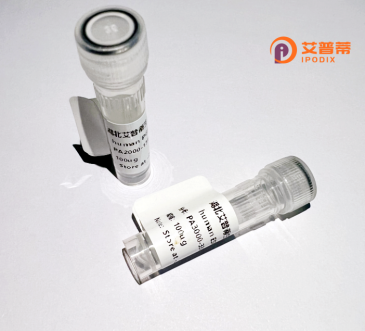
| 纯度 | >90%SDS-PAGE. |
| 种属 | Human |
| 靶点 | KCNG1 |
| Uniprot No | Q9UIX4 |
| 内毒素 | < 0.01EU/μg |
| 表达宿主 | E.coli |
| 表达区间 | 1-275aa |
| 活性数据 | MTLLPGDNSDYDYSALSCTSDASFHPAFLPQRQAIKGAFYRRAQRLRPQDEPRQGCQPEDRRRRIIINVGGIKYSLPWTTLDEFPLTRLGQLKACTNFDDILNVCDDYDVTCNEFFFDRNPGAFGTILTFLRAGKLRLLREMCALSFQEELLYWGIAEDHLDGCCKRRYLQKIEEFAEMVEREEEDDALDSEGRDSEGPAEGEGRLGRCMRRLRDMVERPHSGLPGKVFACLSVLFVTVTAVNLSVSTLPSLREEEEQVRAHAPRGNAPPRGKGL |
| 分子量 | 55.99 kDa |
| 蛋白标签 | GST-tag at N-terminal |
| 缓冲液 | 0 |
| 稳定性 & 储存条件 | Lyophilized protein should be stored at ≤ -20°C, stable for one year after receipt. Reconstituted protein solution can be stored at 2-8°C for 2-7 days. Aliquots of reconstituted samples are stable at ≤ -20°C for 3 months. |
| 复溶 | Always centrifuge tubes before opening.Do not mix by vortex or pipetting. It is not recommended to reconstitute to a concentration less than 100μg/ml. Dissolve the lyophilized protein in distilled water. Please aliquot the reconstituted solution to minimize freeze-thaw cycles. |
以下为3篇关于重组人KCNG1蛋白研究的参考文献:
1. **"Cloning and Functional Expression of the Human KCNG1 Gene (Kv6.1) in Mammalian Cells"**
- **作者**: Kerschensteiner D, et al.
- **摘要**: 该研究首次报道了人KCNG1基因(Kv6.1亚基)在哺乳动物细胞(HEK293)中的重组表达,证实其单独无法形成功能性钾通道,需与其他电压门控Kv亚基(如Kv2.1)共同表达,才可调节通道的门控特性。
2. **"Biophysical Characterization of Recombinant Human KCNG1 Potassium Channel Subunits"**
- **作者**: Salinas M, et al.
- **摘要**: 通过非洲爪蟾卵母细胞系统表达重组人KCNG1蛋白,结合膜片钳技术分析其电生理特性,揭示其作为调控亚基对Kv通道激活阈值及失活动力学的调节作用,为理解Kv6亚家族的功能提供依据。
3. **"Modulatory Effects of KCNG1 Mutations on Cardiac Potassium Currents and Arrhythmia Risk"**
- **作者**: Labro AJ, et al.
- **摘要**: 研究利用重组人KCNG1蛋白及突变体,探究其在心肌细胞Kv通道复合物中的作用,发现特定突变通过改变通道失活动力学,可能导致室性心律失常,为遗传性心脏病机制提供新视角。
这些研究聚焦于KCNG1的重组表达、结构功能分析及病理关联,覆盖基础机制与转化医学领域。
The human KCNG1 protein, a member of the voltage-gated potassium (Kv) channel family, is encoded by the KCNG1 gene (also termed Kv6.1). It belongs to the Kv5–6 subfamilies, which function as "silent" α-subunits that modulate the activity of pore-forming Kv2 subunits by forming heterotetrameric complexes. KCNG1 is primarily expressed in the heart, brain, and nervous system, where it contributes to the regulation of action potential repolarization and cellular excitability. Structurally, it contains six transmembrane domains (S1–S6) with a voltage-sensing domain (S4) and a pore-forming region, though its lack of intrinsic channel activity necessitates co-assembly with Kv2.1/2.2 for functional expression.
Dysregulation of KCNG1 has been implicated in neurological disorders, arrhythmias, and cancer. For instance, mutations or altered expression may disrupt cardiac repolarization, potentially leading to arrhythmogenic conditions. In cancer, aberrant KCNG1 expression has been associated with tumor progression and chemoresistance. Recombinant human KCNG1 protein is typically produced using heterologous expression systems (e.g., HEK293 or CHO cells) to study its biophysical properties, interaction partners, and pharmacological profiles. This protein serves as a critical tool for elucidating the molecular mechanisms underlying Kv channel modulation, high-throughput drug screening for channelopathies, and developing targeted therapies. Research on recombinant KCNG1 also aids in deciphering its role in disease models, particularly in electrophysiological studies using patch-clamp techniques.
×